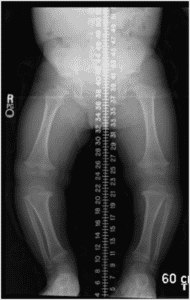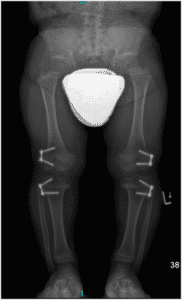Key Techniques: Hemiepiphysiodesis (Guided Growth)
Claire Shannon, M.D.
Paley Orthopedeic and Spine Institute
Hemiepiphysiodesis is a temporary technique used to alter the growth of a limb, particularly to change the limb alignment when it is abnormal. It is commonly referred to as “guided-growth.” The basic principle is to temporarily stop growth on one side of the growth plate while the other side continues to grow. The child’s own growth straightens the bone, avoiding a larger surgery, such as an osteotomy.
Overview:
Growth plates are areas of bones, near the top and bottom, that allow bones to grow in length in children. These areas are made of cartilage and have rapidly growing cells. The growth plates close in each bone at different times as the child gets older. Once skeletal maturity is reached, around age 14 for girls and age 16 for boys, all the growth plates are permanently closed. This timing may vary from child to child, based on factors such as genetics, horomones, or underlying medical conditions. If the growth plates are closed, the shape of the limb cannot be changed without cutting the bones and realigning them, which is a larger surgery.
The most commonly treated growth plates are those around the knees (Figure). They are some of the most rapidly growing areas in the body, and because the knees are so important for walking, they are also some of the most symptomatic when they are altered. Some common problems with the knees are genu varum (bow legs) and genu valgum (knock knees)


Left: Preoperative standing x-ray of a child with genu varum (bow legs). Bilateral hemiepiphysiodesis plates were placed on the femurs and tibias. Right: Follow up standing xray one year after plate insertion with full correction of the bowing. The plates are now ready to be removed
The amount of deformity in the bones and the location of that deformity can be measured on xrays before surgery. Your surgeon may also evaluate the “bone age,” using an xray of the left hand or different body part to determine how close the growth plates are to closing.
Surgical Procedure:
Your surgeon may recommend guided growth for conditions where the limb is abnormally shaped and there is still enough years of growth remaining to change the shape. The surgery is short and your child can generally can go home the same day.
Based on the preoperative imaging, the surgeon will make a small incision over the side of the growth plate where the plate is to be inserted. A small metal plate is then attached to the side of the bone, over top of the growth plate with a screw above and below to hold it. This creates a growth tether, which prevents growth on the side the plate is placed. Alternative implants are staples and screws. Your surgeon will discuss with the implant options with you.
Recovery:
After surgery, your child will be allowed to use their leg normally and start full weight bearing, with crutches generaly only for comfort. It will take a few weeks to heal and for the pain from surgery to go away, but you will be given instructions for what activities are safe to do.
Complications:
Your surgeon will discuss all the risks of the procedure with you in detail. The most common complications are under correction of the leg shape, requiring a larger surgery to correct the limb in the future; joint swelling and stiffness, generally resolved with physical therapy; infection, irritation of the muscles over the plate, or breakage of the plate or screws, often treated with plate removal. Although this is considered a low risk surgery, it is very important to continue following with your surgeon after the surgery to monitor the progress of the correction. If the plate and screws are left in too long in a growing child, the limb can overcorrect into the opposite direction, which may require additional surgery to correct, or in some rare cases, the growth plate may be damaged and stop growing. If the child is still growing, after the plate and screws are removed, the deformity can come back and additional surgery may be recommended, so careful follow up is necessary until the bone is done growing.
Long Term Outcomes
You will need to have frequent follow up with your surgeon as your child continues to grow. Xrays will need to be taken to monitor the growth of the leg as it straightens out every 3-6 months. Once the leg is corrected, the plate generally needs to be taken out if the growth plate is still growing so the leg shape doesn’t get overcorrected. Plate removal is also a minor procedure, and your child will be able to go home the same day. Post-removal activity guidelines will be discussed with you by your surgeon.